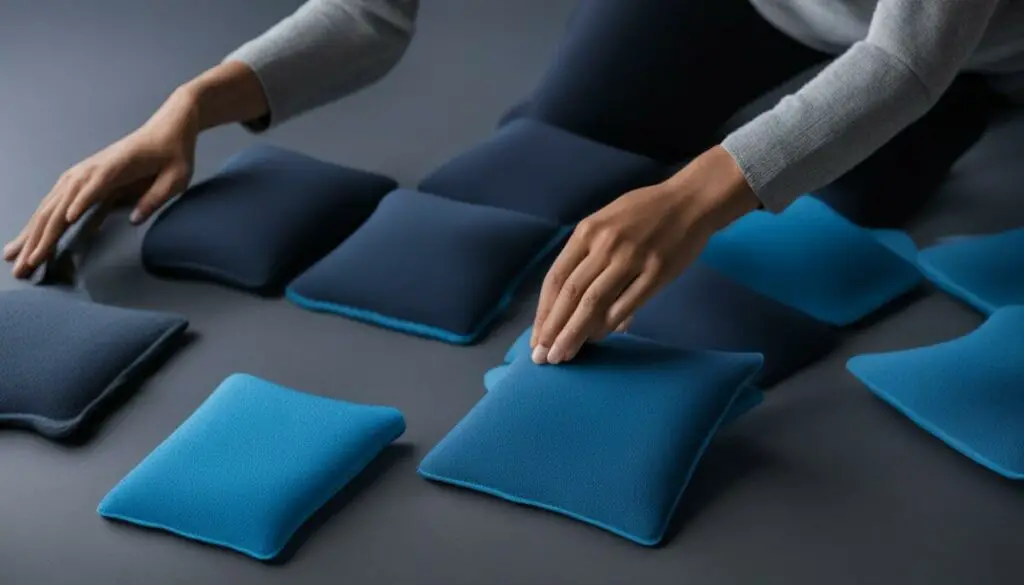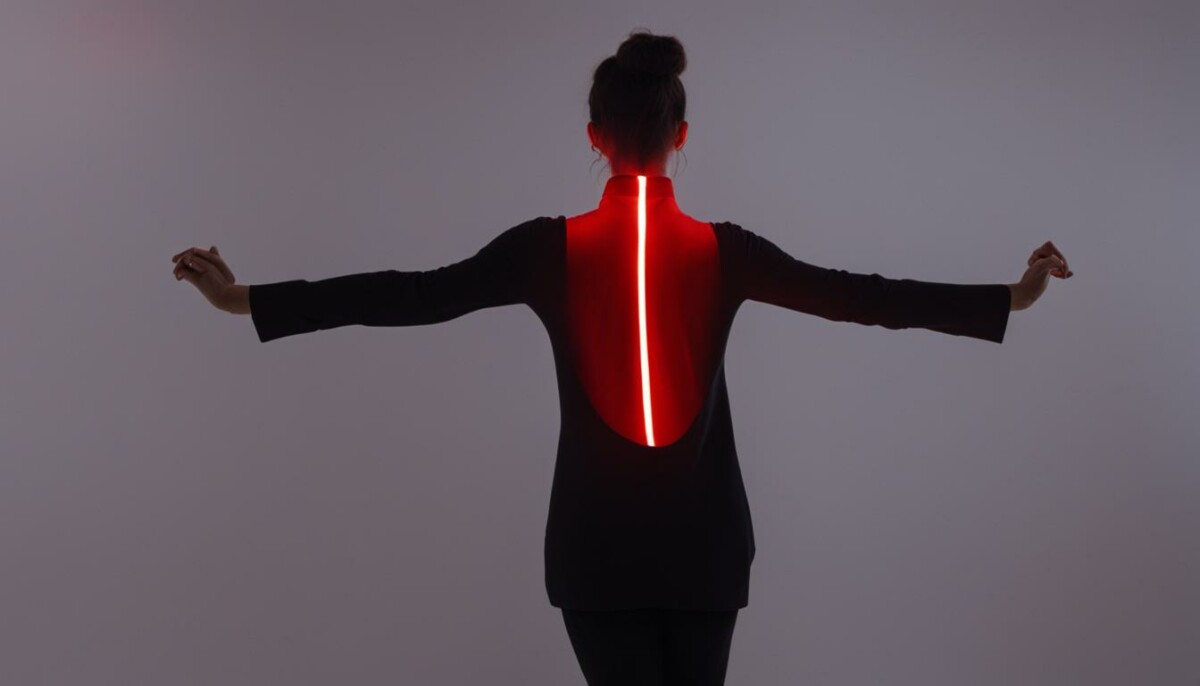Last Updated on 5 months by Francis
Welcome to our in-depth exploration of one burning question: does far infrared radiation have the power to penetrate clothing? Far infrared is a type of thermal energy that is widely used in various applications such as saunas and heating pads. But what happens when it encounters the fabric barrier? Let’s dive into the science behind this intriguing phenomenon and discover the truth!
Contents
Key Takeaways:
- Far infrared radiation is a type of thermal energy.
- It has longer wavelengths than visible light.
- The ability of far infrared to penetrate clothing depends on fabric type, thickness, and density.
- Direct skin contact with far infrared sources tends to provide more significant therapeutic benefits.
- Alternative options, such as infrared clothing, may optimize fabric penetration while still wearing clothes.
What is Far Infrared and How Does it Work?

Far infrared is a type of electromagnetic radiation that has longer wavelengths than visible light. It is often referred to as thermal energy because it can generate heat when absorbed by objects, including the human body. Far infrared works by emitting energy that can penetrate deep into the skin and tissues, providing various health benefits. Understanding how far infrared works is crucial in determining its ability to penetrate clothing.
Far infrared radiation, also known as FIR, is a form of energy that is naturally emitted by the sun. Unlike ultraviolet (UV) radiation, which can be harmful to the skin, far infrared radiation is considered safe and has been used in therapeutic applications for many years.
When far infrared radiation comes into contact with the body, it is absorbed by the skin and underlying tissues. The energy from FIR stimulates the molecules in these tissues, causing them to vibrate and generate heat. This heat then leads to a range of physiological responses, such as increased blood circulation and the release of toxins from the body.
The ability of far infrared radiation to penetrate deep into the body is what sets it apart from other forms of heat therapy. While traditional heat sources, such as hot water bottles or heating pads, only provide surface-level heat, far infrared can reach much deeper layers of tissue. This deeper penetration allows for a more targeted and effective treatment, making it a popular choice for pain relief, relaxation, and overall well-being.
| Key Points | Details |
|---|---|
| Far Infrared Radiation | Far infrared radiation is a type of electromagnetic radiation that has longer wavelengths than visible light. |
| Thermal Energy | Far infrared radiation generates heat when absorbed by the body, stimulating various physiological responses. |
| Penetration into Tissues | Far infrared can penetrate deep into the skin and underlying tissues, providing therapeutic benefits. |
| Physiological Responses | The heat generated by far infrared radiation can increase blood circulation, promote relaxation, and facilitate detoxification. |
Infrared Radiation and the Human Body
Far infrared radiation is not only absorbed by the skin but also interacts with the body at a cellular level. The heat generated by FIR can enhance metabolic processes, promote cell regeneration, and support the immune system. This interaction between infrared radiation and the human body has led to the development of various therapeutic applications.
Infrared saunas, for example, utilize far infrared radiation to provide a range of health benefits. In these saunas, the body is exposed to elevated temperatures that promote sweating and the release of toxins from the body. The deep penetration of far infrared radiation also helps to relax muscles, relieve pain, and improve overall well-being.
Another popular application of far infrared radiation is in heat therapy pads. These pads are often used to alleviate muscle soreness, joint pain, and stiffness. By applying far infrared heat directly to the affected area, the therapy pads help to increase blood flow, reduce inflammation, and accelerate the healing process.
Far infrared radiation, with its ability to penetrate deep into the body, offers a unique therapeutic approach that can address a range of health concerns.
Overall, far infrared radiation is a powerful form of thermal energy that can provide numerous health benefits. Its ability to penetrate the skin and underlying tissues makes it an ideal choice for various therapeutic applications. Whether in the form of infrared saunas or heat therapy pads, far infrared radiation offers a natural and effective way to enhance well-being and promote overall health.
The Benefits of Far Infrared Therapy

Far infrared therapy, also known as thermal therapy, has gained popularity in the wellness industry due to its numerous health benefits. This form of therapy utilizes far infrared radiation, a type of electromagnetic radiation, to generate heat and provide therapeutic effects to the body. The unique properties of far infrared radiation allow it to penetrate the skin and reach deep layers of tissues, stimulating various physiological responses.
Studies have shown that far infrared therapy can help relieve pain, improve blood circulation, promote relaxation, aid in detoxification, and enhance immune function. The deep penetration of far infrared radiation allows for increased blood flow, which can help reduce inflammation and alleviate discomfort associated with conditions such as arthritis, muscle pain, and joint stiffness. By improving circulation, far infrared therapy also aids in the delivery of oxygen and nutrients to the body’s cells, promoting overall well-being.
Furthermore, far infrared therapy has been found to have a positive impact on the cardiovascular system. It can assist in lowering blood pressure, improving heart health, and increasing cardiovascular endurance. The heat generated by far infrared radiation also induces sweating, which helps eliminate toxins and impurities from the body, supporting detoxification processes.
| Benefits of Far Infrared Therapy |
|---|
| Relieves pain and reduces inflammation |
| Improves blood circulation and cardiovascular health |
| Promotes relaxation and reduces stress |
| Aids in detoxification and elimination of toxins |
| Enhances immune function and boosts overall well-being |
“Far infrared therapy has shown promising results in providing natural and drug-free solutions for pain management and overall health improvement. Its ability to penetrate deep into tissues and stimulate various physiological responses makes it a valuable therapeutic option.”
Far infrared therapy can be administered through different methods such as infrared saunas, heat therapy pads, and specialized clothing. While the effectiveness of far infrared therapy when clothing is worn may be slightly reduced, individuals can still experience the benefits to some extent. However, direct skin contact with far infrared sources tends to provide more significant therapeutic effects.
It is important to note that far infrared therapy should be used as a complementary approach alongside conventional medical treatments and under the guidance of a healthcare professional. While it offers promising benefits, individual experiences and results may vary. Consultation with a healthcare provider will ensure that far infrared therapy is safe and appropriate for each individual’s specific needs and conditions.
The Science Behind Fabric Penetration
When it comes to far infrared penetrating clothing, several factors come into play. The type of fabric, thickness, and density can affect the ability of far infrared radiation to pass through. Fabrics with tighter weaves and denser structures, such as synthetic materials and certain blends, may block or absorb more far infrared radiation than looser and more breathable fabrics.
To understand the science behind fabric penetration, it’s essential to consider how far infrared radiation interacts with different types of fabrics. When far infrared radiation encounters a fabric, it can undergo three possible processes: transmission, absorption, or reflection. Transmission occurs when the radiation passes through the fabric without being blocked or absorbed. Absorption refers to the fabric absorbing the radiation, and reflection happens when the radiation bounces off the fabric’s surface.
Studies have shown that certain fabrics, such as nylon and polyester, have a higher absorption capacity for far infrared radiation compared to natural fibers like cotton or wool. This means that when wearing clothing made of synthetic materials, the far infrared radiation may be more likely to be absorbed by the fabric rather than reaching the skin. On the other hand, fabrics with looser weaves and lighter compositions allow for greater transmission of far infrared radiation, increasing the chances of it reaching the skin and providing its therapeutic benefits.
| Fabric Type | Far Infrared Penetration |
|---|---|
| Synthetic Materials (Nylon, Polyester) | Higher absorption, limited penetration |
| Natural Fibers (Cotton, Wool) | Lower absorption, higher penetration |
| Loose Weaves and Breathable Fabrics | Increased transmission and penetration |
Table: Far Infrared Penetration in Different Fabric Types
Therefore, when considering the effectiveness of far infrared therapy while wearing clothing, it is crucial to choose fabrics that allow for better transmission and penetration of the radiation. Opting for looser weaves, lighter compositions, and natural fibers can enhance the chances of experiencing the desired therapeutic benefits. Additionally, maintaining direct skin contact with far infrared sources, such as saunas or heat therapy pads, can further optimize the effectiveness of the therapy.
The Role of Infrared Saunas

Infrared saunas have gained popularity in recent years due to their potential therapeutic benefits. These saunas utilize far infrared radiation to generate heat, which is believed to promote relaxation, detoxification, and other health benefits. However, one question that arises is whether far infrared radiation can effectively penetrate clothing when using an infrared sauna.
While the primary goal of an infrared sauna is to allow the skin to directly absorb the far infrared radiation, it is common practice for individuals to remove their clothing before entering the sauna. This is done to maximize the absorption of the radiation and enhance the therapeutic experience. By removing clothing, the skin is in direct contact with the far infrared radiation, allowing for better penetration and interaction.
However, it is important to note that the therapeutic benefits of infrared saunas can still be experienced even with the presence of clothing. While the effectiveness may be reduced to some extent, far infrared radiation can still penetrate certain fabrics to provide a level of therapeutic benefits. The extent of penetration may vary depending on the type of fabric, its thickness, and density.
Infrared saunas are designed to emit far infrared radiation, providing therapeutic benefits to the user.
Table: Comparing the Penetration of Far Infrared Radiation in Different Fabrics
| Fabric Type | Penetration Level |
|---|---|
| Natural fibers (cotton, linen) | High |
| Lightweight synthetic materials (polyester, nylon) | Moderate |
| Dense or thick fabrics | Low |
As shown in the table above, fabrics made from natural fibers such as cotton and linen tend to allow for a higher level of penetration by far infrared radiation. Lightweight synthetic materials like polyester and nylon may still provide a moderate level of penetration. On the other hand, fabrics that are denser or thicker may hinder the penetration of far infrared radiation.
In conclusion, while the removal of clothing in an infrared sauna allows for optimal skin contact with far infrared radiation, it is still possible to experience therapeutic benefits even with clothing on. The extent of penetration depends on various factors, including fabric type, thickness, and density. Ultimately, individuals can enjoy the benefits of an infrared sauna both with and without clothing, tailoring their experience to personal preferences and comfort.
Understanding Heat Therapy Pads

Heat therapy pads, such as heating blankets and heating pads, are commonly used to provide therapeutic heat to the body. These pads utilize far infrared technology, which raises the question of their effectiveness in penetrating clothing. While far infrared radiation can penetrate the skin, its ability to pass through clothing may be limited by the thickness and composition of the fabric.
To understand the impact of fabric penetration on heat therapy pads, it is essential to consider the specific characteristics of the fabric being used. Fabrics with tighter weaves and denser structures, such as synthetic materials, may hinder the penetration of far infrared radiation. On the other hand, looser and more breathable fabrics may allow for better transmission.
The effectiveness of heat therapy pads in penetrating clothing can vary depending on these fabric factors. It is recommended to choose fabrics that are lighter and have breathable and natural fibers to optimize the absorption of far infrared radiation. By selecting the right fabric and ensuring proper skin contact with the heat therapy pad, individuals can enhance the penetration of far infrared radiation and potentially experience greater therapeutic benefits.
The Importance of Skin Contact
When it comes to experiencing the therapeutic benefits of far infrared therapy, the direct contact between the skin and the radiation plays a crucial role. While far infrared can penetrate clothing to some extent, the benefits are enhanced when the skin is directly exposed to the radiation. Skin contact allows for better absorption and interaction between the radiation and the body, making it more effective in providing the desired therapeutic effects.
By maintaining direct skin contact, individuals can maximize the potential benefits of far infrared therapy. The radiation can penetrate the skin and reach deeper layers of tissues, stimulating various physiological responses that contribute to pain relief, improved blood circulation, relaxation, detoxification, and enhanced immune function. For optimal results, it is recommended to remove clothing or ensure that the clothing allows for sufficient skin exposure to the far infrared source.
While the ability of far infrared to penetrate clothing may be limited, it is important to note that the therapeutic benefits can still be experienced even when wearing clothing. However, the effectiveness may be reduced compared to direct skin contact. Individuals should consider their preferences and the desired therapeutic effects when deciding between direct skin contact or clothing penetration during far infrared therapy sessions.
| Direct Skin Contact vs Clothing Penetration | Benefits |
|---|---|
| Direct Skin Contact |
|
| Clothing Penetration |
|
Image source: https://seowriting.ai/32_6.png
Maximizing Far Infrared Penetration: Tips for Enhancing Clothing Absorption
While far infrared radiation can have therapeutic benefits, its ability to penetrate clothing may be limited. However, there are several tips that can help maximize the effectiveness of far infrared therapy even when wearing clothing.
Choose Lighter and Looser Clothing
Opting for lighter and looser clothing allows for better airflow and reduces the barrier between your body and the far infrared source. Natural fibers such as cotton or linen are breathable options that can help enhance fabric penetration. Avoid tight-fitting garments that can restrict the transfer of far infrared radiation.
Consider Fabrics with Breathable and Natural Fibers
Selecting fabrics with breathable and natural fibers can improve the absorption of far infrared radiation. These fabrics allow for better airflow and can help prevent the build-up of heat between your body and the clothing. Examples of breathable and natural fibers include cotton, bamboo, and silk.
Ensure Proper Skin Contact with the Far Infrared Source
Direct skin contact with the far infrared source is crucial for maximizing its penetration. To achieve this, ensure that the far infrared device or therapy pad is in direct contact with your skin, without any clothing barriers in between. This allows for better heat transfer and absorption of the therapeutic radiation.
By following these tips, individuals can enhance the penetration of far infrared radiation through clothing and potentially experience greater therapeutic benefits. However, it is important to note that direct skin contact tends to provide more significant results. Therefore, consider adjusting your clothing or seeking alternative options if maximum absorption is desired.
The Bottom Line: Does Far Infrared Penetrate Clothing?

Far infrared radiation, also known as thermal energy, has the ability to penetrate certain fabrics to some extent. However, the effectiveness of far infrared in penetrating clothing depends on several factors, including the type of fabric, its thickness, and density. Fabrics with tighter weaves and denser structures, such as synthetic materials and certain blends, may block or absorb more far infrared radiation than looser and more breathable fabrics.
While direct skin contact with far infrared sources, such as saunas or heat therapy pads, tends to provide more significant therapeutic benefits, wearing clothing does not completely negate the potential benefits of far infrared therapy. It is important to note that some far infrared radiation can still pass through clothing, albeit to a lesser degree.
To maximize the absorption of far infrared radiation when wearing clothing, there are certain tips that can be followed. Choosing lighter and looser clothing made with breathable and natural fibers can help optimize the penetration of far infrared. Additionally, ensuring proper skin contact with the far infrared source, even while wearing clothing, can enhance the therapeutic effects.
Table: Factors Affecting Far Infrared Penetration
| Type of Fabric | Thickness | Density |
|---|---|---|
| Synthetic materials and blends | Thicker fabrics | Tighter weaves |
| Loose, breathable fabrics | Thinner fabrics | Less dense weaves |
While far infrared may have limitations in penetrating clothing, it is still possible to experience some therapeutic benefits even when wearing clothing. Direct skin contact with the far infrared source is ideal for maximum absorption and effectiveness.
Ultimately, the choice between direct skin contact or clothing penetration depends on individual preferences and the desired therapeutic effects. For those who prefer to keep their clothing on, alternative options such as infrared clothing and accessories specifically designed for fabric penetration may be worth exploring. These specialized products incorporate infrared technology to optimize the absorption of far infrared radiation while still wearing clothing.
Exploring Alternative Options
While direct skin contact is often recommended for optimal absorption of far infrared radiation, alternative options are available for individuals who prefer to keep their clothing on during therapy sessions. Infrared technology has paved the way for specialized clothing and accessories that are designed to enhance fabric penetration and maximize the effectiveness of far infrared therapy.
One alternative option is the use of infrared clothing, which is specifically constructed with fabrics that have been infused with ceramic particles or other materials that promote far infrared radiation absorption. These garments are designed to allow the penetration of far infrared radiation through the fabric and onto the skin, providing the potential for therapeutic benefits while still wearing clothing.
Another option is the use of infrared accessories, such as wraps or pads that can be worn over clothing. These accessories are typically made with specialized fabrics and materials that enhance the penetration of far infrared radiation. They can be positioned over specific areas of the body, allowing for targeted therapeutic effects.
Benefits of Alternative Options
“Infrared clothing and accessories offer a convenient and accessible way to experience the benefits of far infrared therapy while wearing clothing. They provide flexibility and versatility for individuals who may not be comfortable with direct skin contact or who prefer to incorporate far infrared therapy into their daily activities.”
It is important to note that the effectiveness of alternative options may vary depending on factors such as the quality and construction of the clothing or accessory, as well as individual preferences and needs. Consulting with a healthcare professional or therapist experienced in far infrared therapy can provide guidance on selecting the most suitable alternative option for specific therapeutic goals.
| Alternative Option | Description |
|---|---|
| Infrared Clothing | Clothing infused with ceramic particles or other materials that enhance far infrared radiation absorption. |
| Infrared Accessories | Wraps or pads made with specialized fabrics and materials that promote the penetration of far infrared radiation. |
Conclusion
In conclusion, far infrared radiation has the potential to penetrate clothing to some extent, but its effectiveness may be reduced compared to direct skin contact. The ability of far infrared to penetrate fabric depends on various factors, such as the type of fabric, its thickness, and density.
Fabrics with tighter weaves and thicker composition are more likely to block or absorb far infrared radiation. Therefore, individuals who want to experience the full therapeutic benefits of far infrared therapy may consider removing their clothing or opting for lighter fabrics that allow for better penetration.
However, it is important to note that even when wearing clothing, the therapeutic benefits of far infrared therapy can still be experienced, albeit to a lesser degree. The choice between direct skin contact or clothing penetration ultimately depends on individual preferences and the desired therapeutic effects.
In summary, while far infrared may not fully penetrate clothing, it is still possible to derive some therapeutic benefits from far infrared therapy even when wearing clothes. Exploring alternative options, such as infrared clothing and accessories, can also provide individuals with more flexibility in experiencing the benefits of far infrared radiation.
FAQ
Can far infrared radiation penetrate clothing?
Far infrared radiation can penetrate clothing to some extent, but its effectiveness may be reduced compared to direct skin contact.
What factors affect the ability of far infrared radiation to pass through fabric?
The type of fabric, its thickness, and density can affect the ability of far infrared radiation to pass through clothing.
Do tighter weaves and denser fabrics block more far infrared radiation?
Fabrics with tighter weaves and denser structures, such as synthetic materials and certain blends, may block or absorb more far infrared radiation than looser and more breathable fabrics.
How does skin contact with far infrared sources affect the therapeutic effects?
Direct skin contact with far infrared sources allows for better absorption and interaction between the radiation and the body, making it more effective in providing therapeutic benefits.
Are there any tips for maximizing far infrared penetration through clothing?
Wearing lighter and looser clothing, choosing fabrics with breathable and natural fibers, and ensuring proper skin contact with the far infrared source can help maximize penetration.
Can far infrared therapy still be effective with clothing on?
Far infrared therapy can still be effective with clothing on, although the therapeutic benefits may be slightly reduced compared to direct skin contact.
Are there alternative options available for experiencing far infrared therapy while wearing clothing?
Yes, there are infrared clothing and accessories specifically designed to optimize fabric penetration and enhance the effectiveness of far infrared therapy while still wearing clothing.
What determines the choice between direct skin contact or clothing penetration for far infrared therapy?
The choice between direct skin contact or clothing penetration depends on individual preferences and the desired therapeutic effects.








